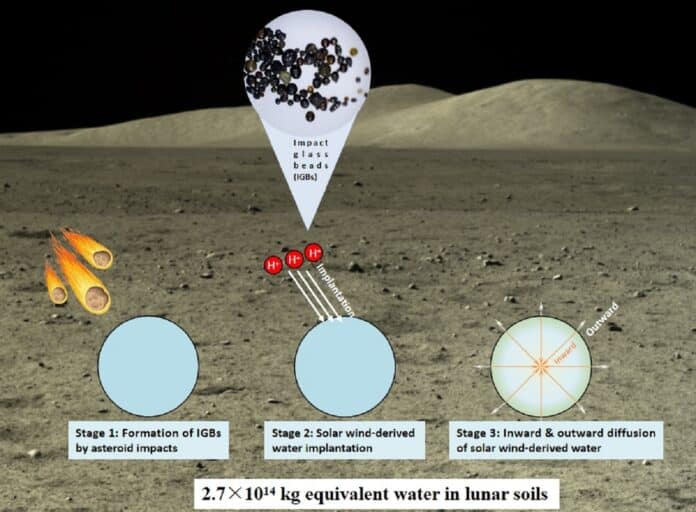It has long been argued that there could be water and other volatile species at the surface of the Moon. The past two decades of lunar exploration have detected substantial quantities of water on the Moon’s surface.
It has been proposed that a hydrated layer exists at depth in lunar soils, buffering a global water cycle on the Moon. However, a reservoir has yet to be identified for this hydrated layer.
Scientists from the Institute of Geology and Geophysics (IGG) of the Chinese Academy of Sciences (CAS) have reported the abundance, hydrogen isotope composition, and core-to-rim variations of water measured in impact glass beads extracted from lunar soils returned by the Chang’e-5 mission. They found that impact glass beads in Chang’e-5 (CE5) lunar soils contain some water.
According to thorough investigations, these glass beads are probably a brand-new water reservoir on the Moon that records the dynamic entry and exit of water derived from the solar wind and serves as a protective barrier for the lunar surface water cycle.
Prior investigations into the water content of lunar soils’ small mineral grains, impact-produced agglutinates, volcanic rocks, and pyroclastic glass beads have not been able to explain how water is retained, released, and replenished on the Moon’s surface (i.e., the lunar surface water cycle). Thus, a water reserve that can withstand the lunar surface water cycle must exist in the soils of the Moon.
Impact glass beads, a common component of lunar soils with an amorphous character, were suggested by doctoral candidate HE Huicun under the supervision of Prof. HU Sen as a prospective candidate for research into the unexplained hydrated layer or reservoir in lunar soils.
She thoroughly analyzed the petrography, major element composition, water abundance, and hydrogen isotope composition of the impact glass beads returned by the CE5 mission to locate and describe the missing water reservoir on the Moon’s surface.
The exposed surfaces of the CE5 impact glass beads are smooth and have uniform chemical compositions. Extreme deuterium depletion characteristics and water abundance up to 2,000 g.g-1 define them. The fact that water in the CE5 impact glass beads is derived from solar winds is reflected in the negative association between water abundance and hydrogen isotope composition.
The water abundance along six transects in five glass beads was also examined by the scientists, revealing the hydration profiles of water derived from the solar wind. A subsequent degassing operation overlapped some of the glass beads. The impact glass beads spongily absorbed the lunar surface water cycle. The amount of water that impacts glass beads are thought to have added to lunar soils ranges from 3.0 1011 kg to 2.7 1014 kg, according to the study.
Prof. HU Sen said, “These findings indicate that the impact glasses on the surface of the Moon and other airless bodies in the solar system are capable of storing solar wind-derived water and releasing it into space.”
Journal Reference:
- He, H., Ji, J., Zhang, Y. et al. A solar wind-derived water reservoir on the Moon hosted by impact glass beads. Nat. Geosci. (2023). DOi: 10.1038/s41561-023-01159-6
